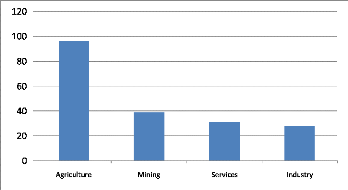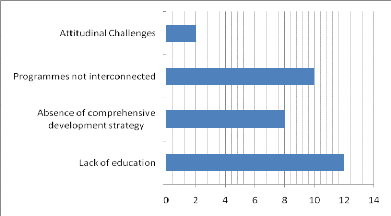4.1.2.14 Availability of Technical Challenges with
regards to Implementation of MDGs
Table 4.5:
|
Response
|
Frequency
|
Percentage (%)
|
|
Yes
|
24
|
75.0
|
|
No
|
8
|
25.0
|
|
Total
|
32
|
100.0
|
The study reveals that it is the view of the majority, 75% of
the participants that the Donor Community could be facing technical challenges
with regards to the implementation of MDGs. These include attitudinal
constraints and other socio-economic constraints. The specific challenges are
further shown by the diagram below.

Figure 4.10: Challenges with regards to
Implementation of MDGs

According to ECA (2005) provided development partners
appropriately harness existing resources, most of the MDGs are achievable. Part
of the challenge is making sure that programmes are interconnected, so that
when addressing primary education, for example, a comprehensive development
strategy would also incorporate natural resource management and health
education.
4.1.2.15 Ranking Rwanda's main Resources in order of
importance
Figure 4.11:
It emerged from the survey that agriculture is the backbone of
the people and government?s needs, 96% of the participants indicated so.
Mining, services and industry in that order are important to a lesser extent.
Koster (2008), shows that in July 2006, the population was estimated at
8,648,248, of which the large majority (93.4 percent) lives in the rural areas
and that large majority of people (over 90 percent) depends on agricultural
subsistence production.
4.1.3 Overall synthesis of findings from the
questionnaire
The results obtained from then open-ended questionnaire concur
with the focus group discussion/interview results. All of them showed that
poverty was a phenomenon so real that its negative impact on the national
economy cannot be contested. This picture was shown more vividly at village
level. The case of Kimironko Sector deserves special mention. It is one of the
3 urban sectors of the District and accommodates «Centre
Cesar» which takes care of Genocide survivors to develop themselves
socially and economically. According to the results from the discussions with
the villagers, poverty is all about failing to avail the basic necessities of
life to oneself or the family. This group was partially aware of MDGs but as
captured earlier, none of them really bothered about poverty at national
level.
4.2 Qualitative Analysis of Findings

In-depth structured Interviews Observational schedules
Documentary analysis procedures
This part presents a synthesis of major findings from
interviews, documentary analysis and researcher observation. It begins with an
overview of aid coordination background followed by responses from the three
major respondents: non-governmental organisations, government officials and the
public representing the target beneficiaries of donor aid.
| 


